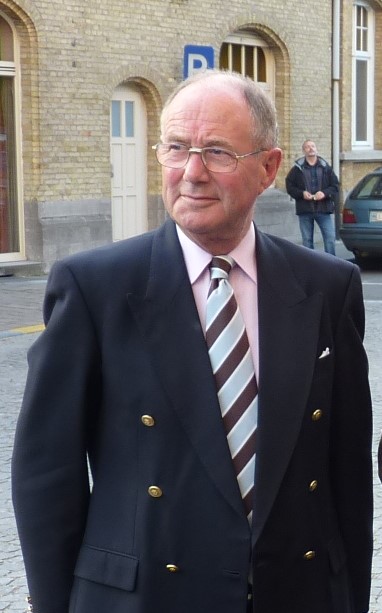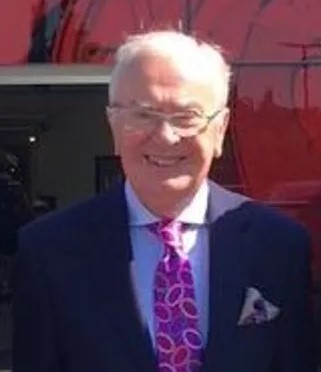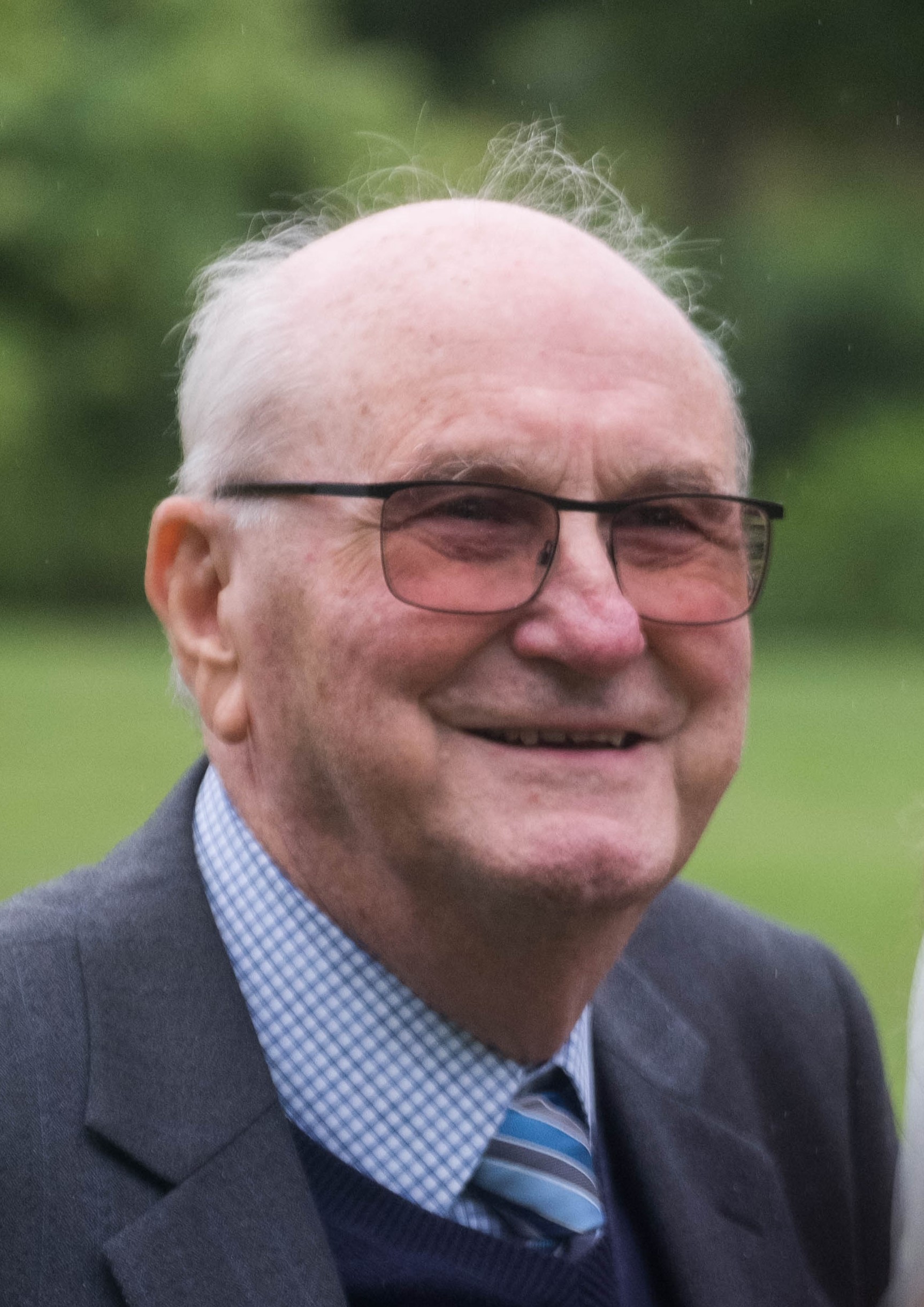Noticeboard
A collection of news about the wider OF Family. We rely entirely on people like you for these entries. If you’re logged in, you can post directly to the relevant section. If you aren’t, and even if you aren’t an OF, you can go to Contact Us (top of your screen) and complete a form to send us your news.
Deaths
Angus Howard Cundey MBE (G50-54)
-
When12 August 2024
-
Age87
Angus Cundey, known affectionately as The Godfather of Savile Row and the driving force behind Henry Poole & Co for many years, has died after a short illness. He was 87.
The company, now headed by his son Simon, made the following announcement at the time of his death : “It is with a very heavy heart that we share this message. After a short battle with cancer, Angus H Cundey MBE, the sixth generation to lead our family business, passed away peacefully at his home on August 12.“He lived and breathed Henry Poole, built special relationships with clients, and was fond of and proud of the skills of all the staff and of their achievements in making Henry Poole what it is today: one of the finest tailors in the world. He was called “the Godfather of Savile Row” as he fought continuously to achieve the Row’s global recognition, its protection and preservation. He was the chairman of trade-related organisations such as the FMT in Europe, the SRB and the BTBA. He was much loved by the trade and all the people involved in it, and was honoured with an MBE for his services to the industry. He leaves a legacy and will be greatly missed by all of us. Rest in peace.”
Click here to read his Distinguished biography.
Deaths
Nigel Philip Simper (R53-60)
-
When11 June 2024
-
WhereSuffolk
-
Age81
NIGEL PHILIP SIMPER (R53-60) died on 11th June 2024, aged 81 years. He passed away peacefully, after a short illness, at home with his family. Devoted husband, caring father and loving grandfather. A celebration of his life took place on Monday 1st July, 2024, at Seven Hill Crematorium, Ipswich.
Deaths
David John Mitchell (R50-57)
-
When28 July 2024
-
WhereHertfordshire
-
Age84
DAVID MITCHELL (R50-57) died on 28th July 2024 at the age of 84. He was a great servant of the Society and in particular the OF Golf Society, of which he was a Past Captain.
The picture was taken in 2014 when he was part of the SOF’s “Three Heroes” tour of France/Belgium. Itwas taken on the final night in Ypres at the Menin Gate ceremony, still held every evening at 8pm to commemorate the fallen.
David was born on the 29th January 1940 and died aged 84, at St Francis, Berkhampsted on the 28th July 2024. He went to Brandeston at the age of 10 from Keble House Bays Prep School in Winchmore Hill before moving on to Framlingham. It seems that his favourite subject in those pre-technology days was “Woodwork”, learnt under the affable eye of the legendary “Doodie” Day.
He left school at 17 and joined his father as a Textile Manufacturing Agent. He worked in Harrods for a year, and this was followed by a year in Belfast working with the Irish Linen Company. The Family firm was now set up as FG Mitchell and Sons, with David and his father, together with brother, Andrew operating in the City of London, and specialising in the Linen trade.David joined Brookmans Park Golf Club in 1970. He served on the General and Greens Committee for several years. He also became a proud member of the MCC and the MCC Golfing Society. He spent many a test match at Lords with friends from Framlingham and Brookmans Park.David met Sue in 1959 and they married in 1964. They had two children, Paul and Louise, plus four grandchildren and three great grandchildren.
David’s Funeral Service was held at St Mary’s Church, Essendon, Herts, on Friday 23rd August, with a gathering afterwards at Brickendon Golf Club, Pembridge Lane, SG13 8PD.
Deaths
Rachel Margaret Smith (nee Knights)(V93-02)
-
When14 July 2024
-
WhereSuffolk
-
Age40
Rachel died on Sunday 14 July 2024 of a heart attach while having a blood transfusion in hospital. She was only 40 and was Secretary of Framlingham Tennis Club.
Private family cremation followed by a service at St Michael’s Church, Framlingham at 1pm on Friday August 16th 2024.
Deaths
Jonathan Alastair Easey (R80-87)
-
When23 June 2024
-
WhereEye, Suffolk
-
Age55
‘Jon’ (R80-87) died at home on June 23rd, at the age of 55. His wife, Sally, was at his side and he was surrounded by his family, including his newly arrived grandson, William Jonathan Easey.
He was father to Benjamin (R 03-12), Thomas (R 03-16) and Harry (R 04-18) as well as brother of Chris Easey (R 80-88) and brother-in-law to Jane Easey (V 87-89), former SOF Liaison Officer at the College.
Jon, who started his career in the wine and brewing industry, successfully built the UK’s largest independent pig breeding and finishing business together with his father and brother. Jon and Chris eventually sold the business to Danish Crown in 2017. Since then, Jon split his time between the family farm in Suffolk and his home in Antigua, maintaining his business interests but able to spend more time with his family.
Jon was also a keen and accomplished shot.
Nearly 13 years ago Jon was diagnosed with thyroid cancer. Rather than being defined by his diagnosis, Jon shaped his life around regular visits to the Royal Marsden Cancer Hospital in London together with his wife Sally, loving and enjoying life to the full. A composite bon viveur, Jon’s amazing resilience, appetite for fun and good company will be enormously missed by his family and many friends.
Deaths
John Geoffrey Thurlow (K48-55)
-
When8 June 2024
-
WhereBury St Edmonds, Suffolk
-
Age85
JOHN G THURLOW (K48-55) died on Saturday 8th June, just 12 days after the death of his wife, Peggy. They had met at the Young Farmers Club in the early 1960s. The then Miss Peggy Wrinch (another Framlingham family) was the Club Secretary, and John was the Club Chairman. The couple married at Earl Stonham Church in 1962. They had three children: James, Nic(ola) and Sally.
After leaving school John completed his National Service with REME and then returned to the family business, George Thurlow & Sons Ltd, based in Stowmarket, Suffolk. He took over the running of the business following his father’s death in 1968 and was now the fourth generation family member to control the business. In 2020 he finally retired from the business after 65 years of service, but continued to take an active interest in it. He was rightly proud of the family business and all it represented. Following his retirement it still remains very much a family business. John’s son, James – (K78-89) is Chairman of the Group, and his grandson, William Tew (G04-09) is Managing Director. John’s legacy, rooted in the county’s agricultural heritage, lives on, with the sixth generation now in charge of a company which, set up in 1875, now employs 700 people and operates from 18 locations across East Anglia
John’s life, energies and profile took him into positions way beyond those of the family business. He was appointed High Sheriff of Suffolk in 2003. He was also a Past President, Chairman and Hon. Director of the Suffolk Agricultural Association, the Suffolk Show being the highlight of his year. The Thurlows are the show’s longest running stand-holders, having exhibited for more than 100 years. He had the honour of showing the Queen Mother around the stand on the occasion of her visit. Framlingham remained close to John’s heart and he wore his OF tie with pride. He was a Governor of the College and Vice President of the SOF.
In their later years John and Peggy enjoyed bridge and horse racing. Sadly, John was diagnosed with vascular dementia in 2018. As his family said, he faded away, but his memory was still active with memories of the company he had led so proudly. The company vowed to maintain the family feel of the company, something of which John had been so proud.
A joint Thanksgiving Service was held in Bury St Edmunds on July 2nd.
See link to Distinguished biography – click here
Deaths
Christopher David Webster (K50-53)
-
When20 February 2024
-
WhereVictoria, British Columbia, Canada
-
Age87
-
Story
CHRISTOPHER DAVID WEBSTER (K 50-53) died on 20 February 2024 in Victoria, British Columbia, Canada. He was 87. He leaves behind his (second) wife, Dianne Macfarlane; his sons, Tim and Paul; daughter-in-law, Margaret (Tim); grandson, Michael; and granddaughter, Rosa. He was tragically predeceased by his grandson, Thomas Webster, in April 2023.
Deaths
Brian Leslie Stannard (G54-63)
-
When27 November 2022
-
Age78
Brian was born in Ipswich in 1944 and spent all his early years in Framlingham. He went to Brandeston Hall and then to Framlingham College where he developed his love of languages, particularly German. He took French and German at ‘A’ level although he would have liked to have taken a science subject as well, this was not available at the time. He obtained a degree in French and German at King’s College London and then studied for the Kew Diploma at Kew Gardens. After successfully completing the course, he joined the Gardens on a permanent basis as a taxonomic botanist working in the Herbarium. He met his wife to be Oona while living in Kew and they were married in November 1975.
His work at Kew involved many trips around the world. He worked in herbaria in Russia, Australia, New York, Cameroon and Brazil. His work also involved field trips to collect, identify and catalogue plant specimens. Initially his work took him to Malaysia and Africa. On one trip to Kenya the group accidentally strayed across the border into Uganda and were intercepted by troops from Idi Amin’s army. On another to Cameroon he was taken to a local restaurant by one of the local botanists. He did not know what he was eating but was, at the end of the meal, startled to hear his host declare that it was the best armadillo he had ever eaten. After Africa he then made several trips to South America, in particular Brazil, becoming fluent in Portuguese whilst there. Again, these trips were not without incident. One of his first trips was to Venezuela just after the Falkland’s War. Oona had arranged to fly to Caracas to have a holiday with him at the conclusion of the expedition. Oona had not heard from him for several months but that was no surprise considering the location of the trip and the lack of available communication systems at that time. She was, however, surprised to be met by staff from the British Embassy in Caracas who told her they had expected Brian to have already been back but communication was proving difficult. They admitted that they were concerned for his safety. A short while later a car arrived from the Embassy and she was told to pack up and go to the embassy. They had received word that Brian and others were presumed dead and they needed to break the news to her. As she was getting in the car an emaciated dishevelled man appeared from the street – Brian. It turned out that the expedition was a cover for nefarious activities by one of the organisers. He had appropriated the helicopter used to ferry the scientists into the jungle and had abandoned them on the top of a mountain without any food or many supplies. They had to eat monkey and anything that they could forage as they made their slow and perilous way down the mountain and back to civilisation.
In addition to his travels Brian was scientific coordinator on the development and building of a new wing for Kew’s herbarium. He was also involved in the writing of a number of scientific papers, his most significant work was probably much of the writing, editing and bringing to publication a book on the Flora of the Pico Das Almas, Brazil.
In addition to his work at Kew he loved to travel, including making frequent visits back to Suffolk, going to the theatre, sport – he was a hockey blue at King’s, and dining out, and being with family and friends.
For the last twelve years of his life he coped valiantly with Parkinson’s disease refusing to be defined by it, continuing to travel and enjoy a good social life.
Brian passed away 27th November 2022.
Deaths
Clive Carrington Simpson (K49-53)
-
When15 January 2024
-
WhereHalstead, Essex
-
Age85
CLIVE CARRINGTON SIMPSON (K49-53) passed away peacefully on 15th January 2024, aged 85 years. Clive was part of a long line of ‘Simpsons’ who have attended Framlingham College from 1865 onwards. He followed his father Frank, and brother Guy to the College and always spoke very fondly of his time spent there.
Clive built a career as an Agricultural Engineer, initially with Eastern County Farmers in Ipswich, and latterly, for many years, with Carriers in Braintree. He gained a considerable reputation in his field of designing and building grain driers and material elevators used in both agriculture and manufacturing. He became an expert advisor to Essex University and assisted in setting up a degree course in Agricultural Engineering. He went on to lecture there and at Writtle College.
Clive enjoyed a long and happy marriage to Judy. He is survived by his children, Jayne, and Richard, and grandchildren, Guy and Kate.








